Matches and mismatches between EFL teachers’ and students’ preferences for corrective feedback in English speaking classes at a Vietnamese University
This study aimed at examining matches or mismatches between teachers’ and students’
preferences regarding different types of corrective feedback in EFL (English as a foreign language)
speaking classrooms at a Vietnamese university. Observation and two parallel questionnaires adapted from
Katayama (2007) and Smith (2010) were used to gather data from five EFL teachers and 138 Englishmajored students. Multiple findings pertaining to each research question were revealed. Overall, the results indicated that while there were some areas of agreement between teachers and students, important mismatches in their opinions did occur.
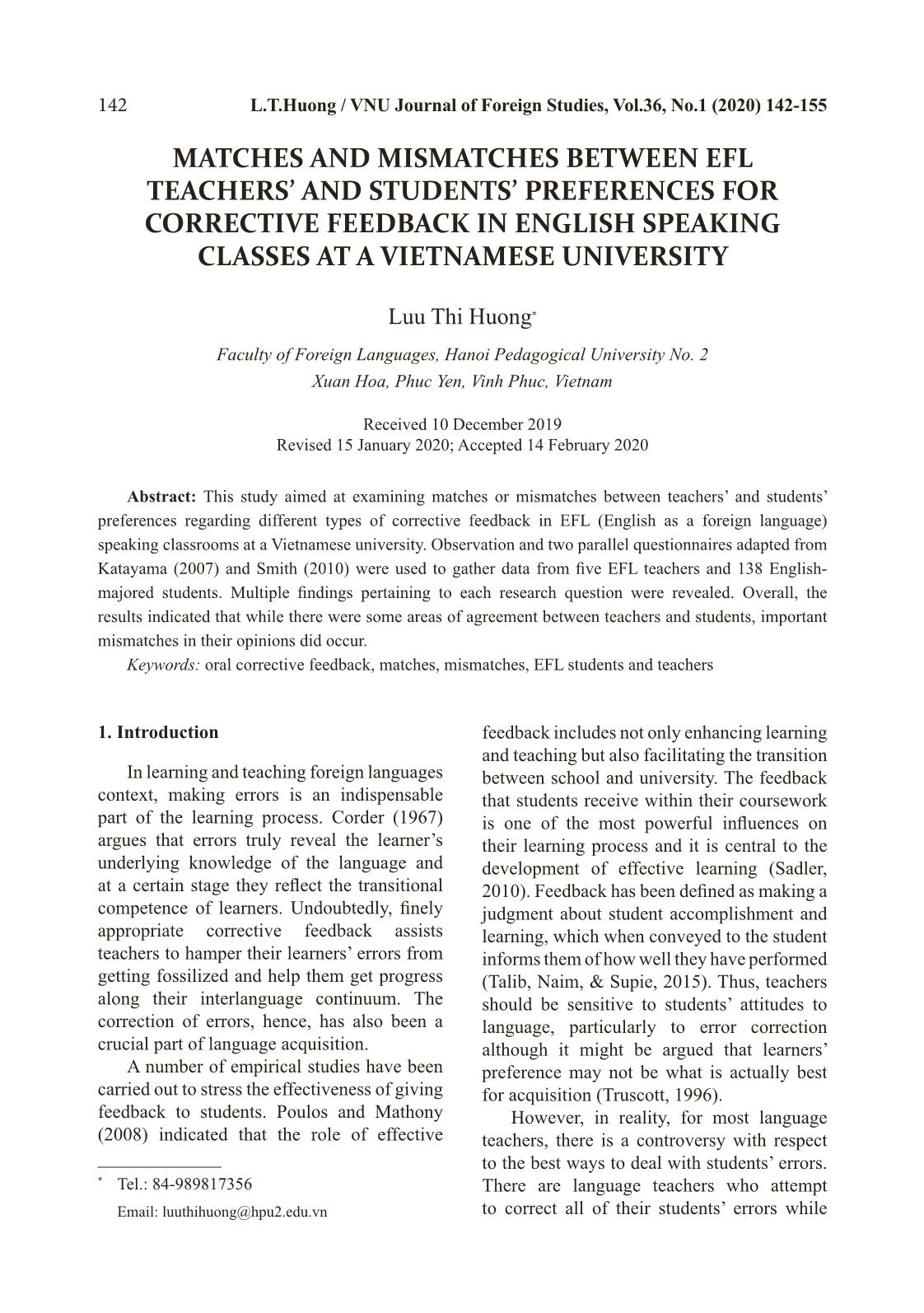
Trang 1
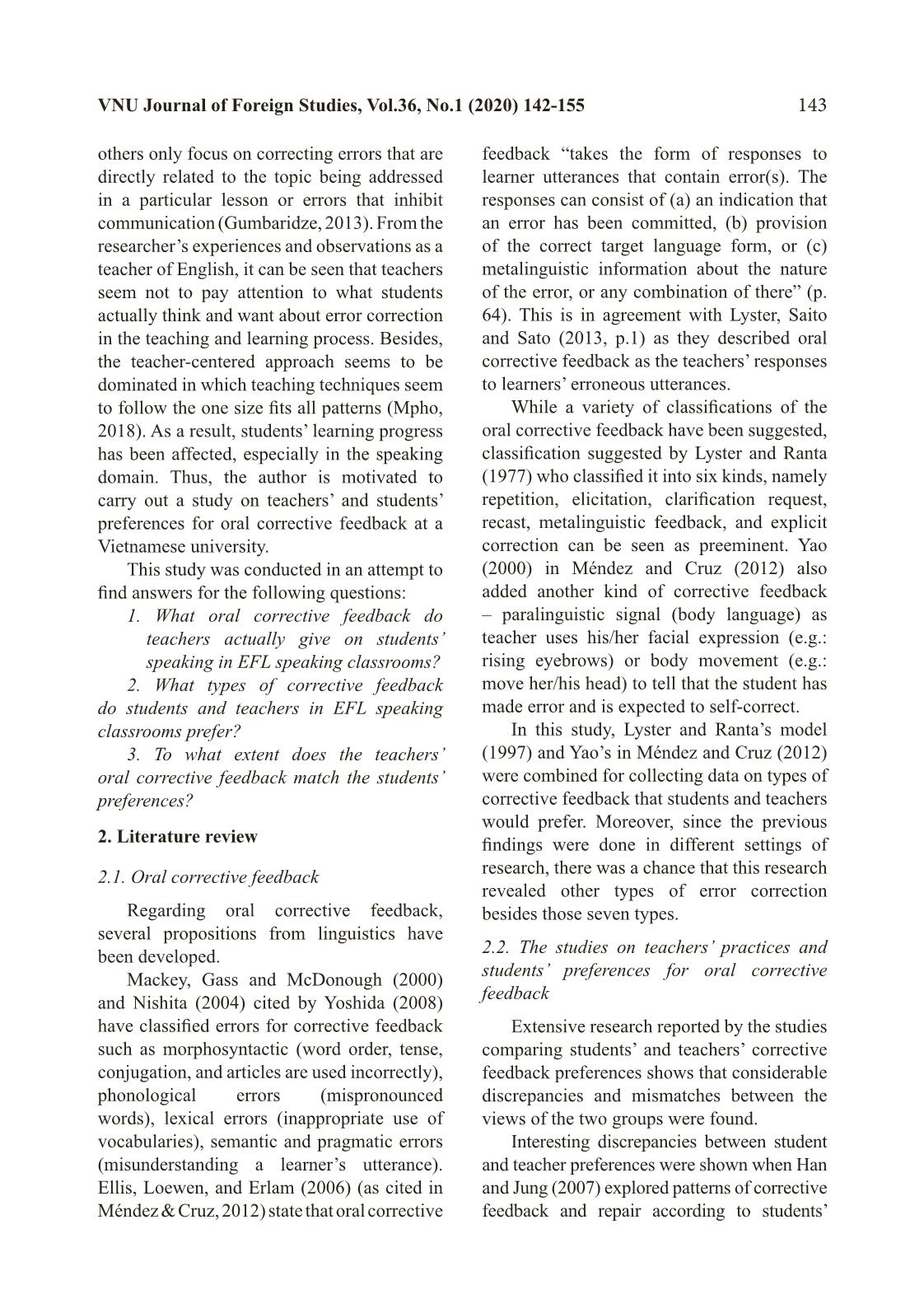
Trang 2
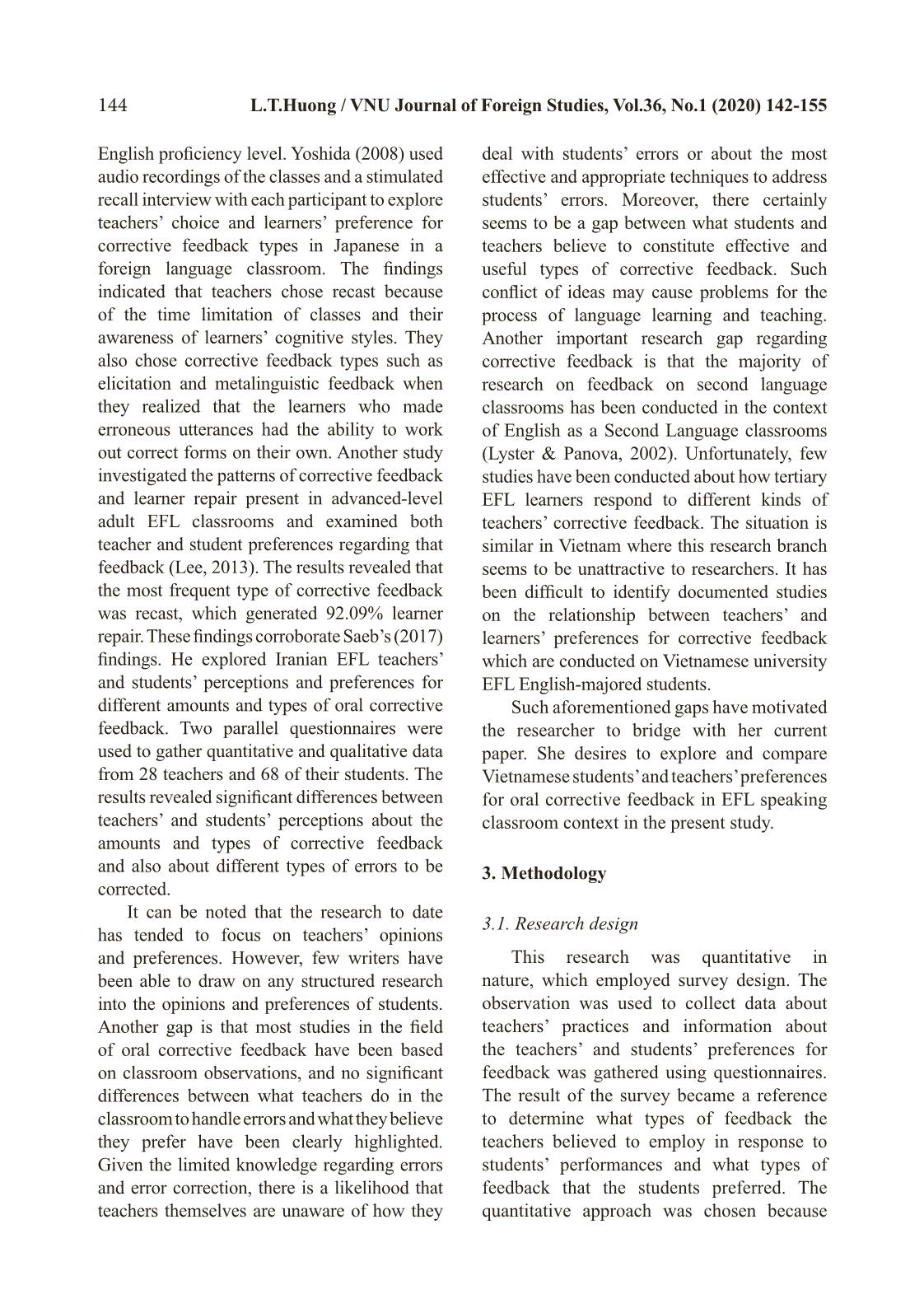
Trang 3
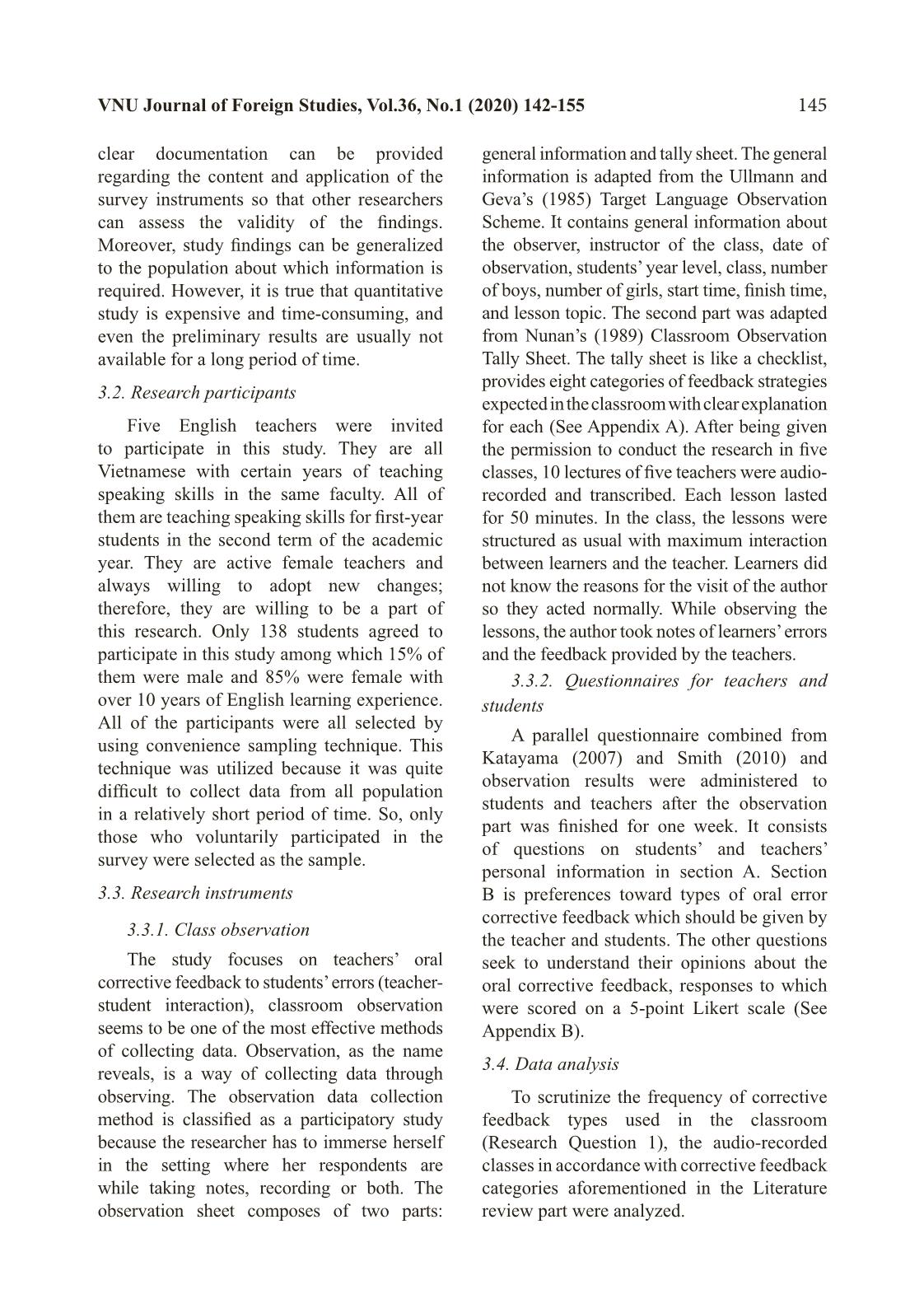
Trang 4
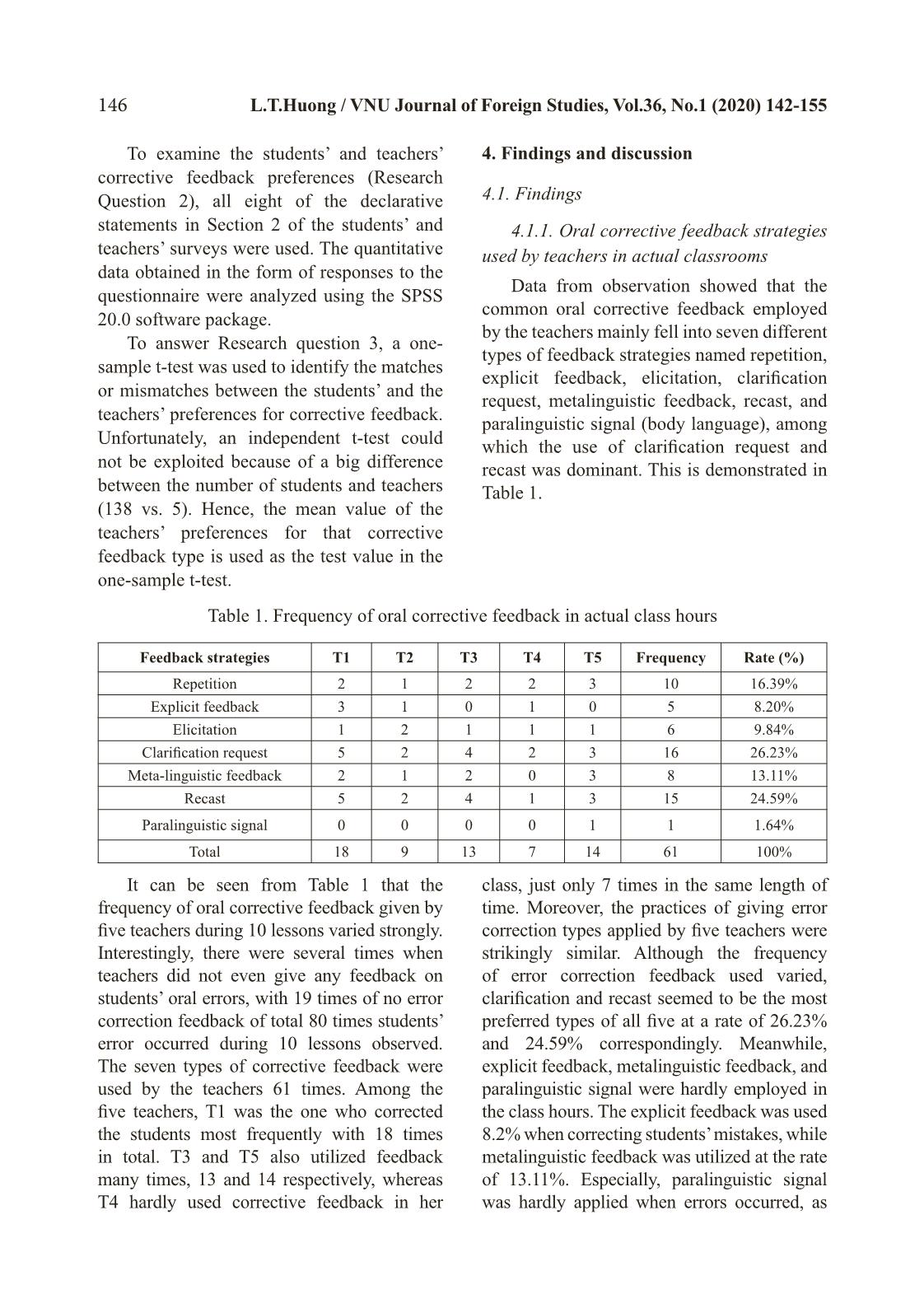
Trang 5
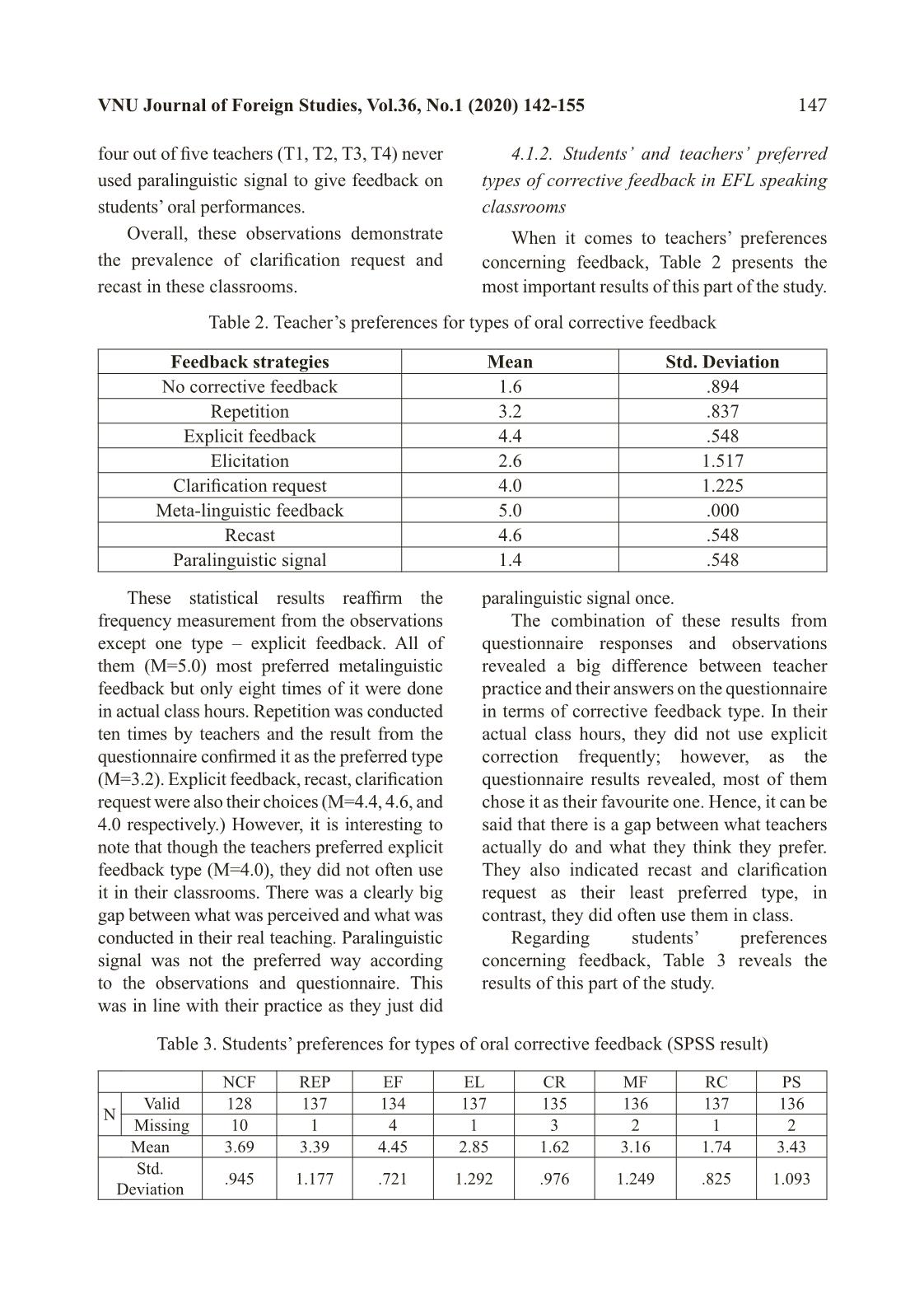
Trang 6
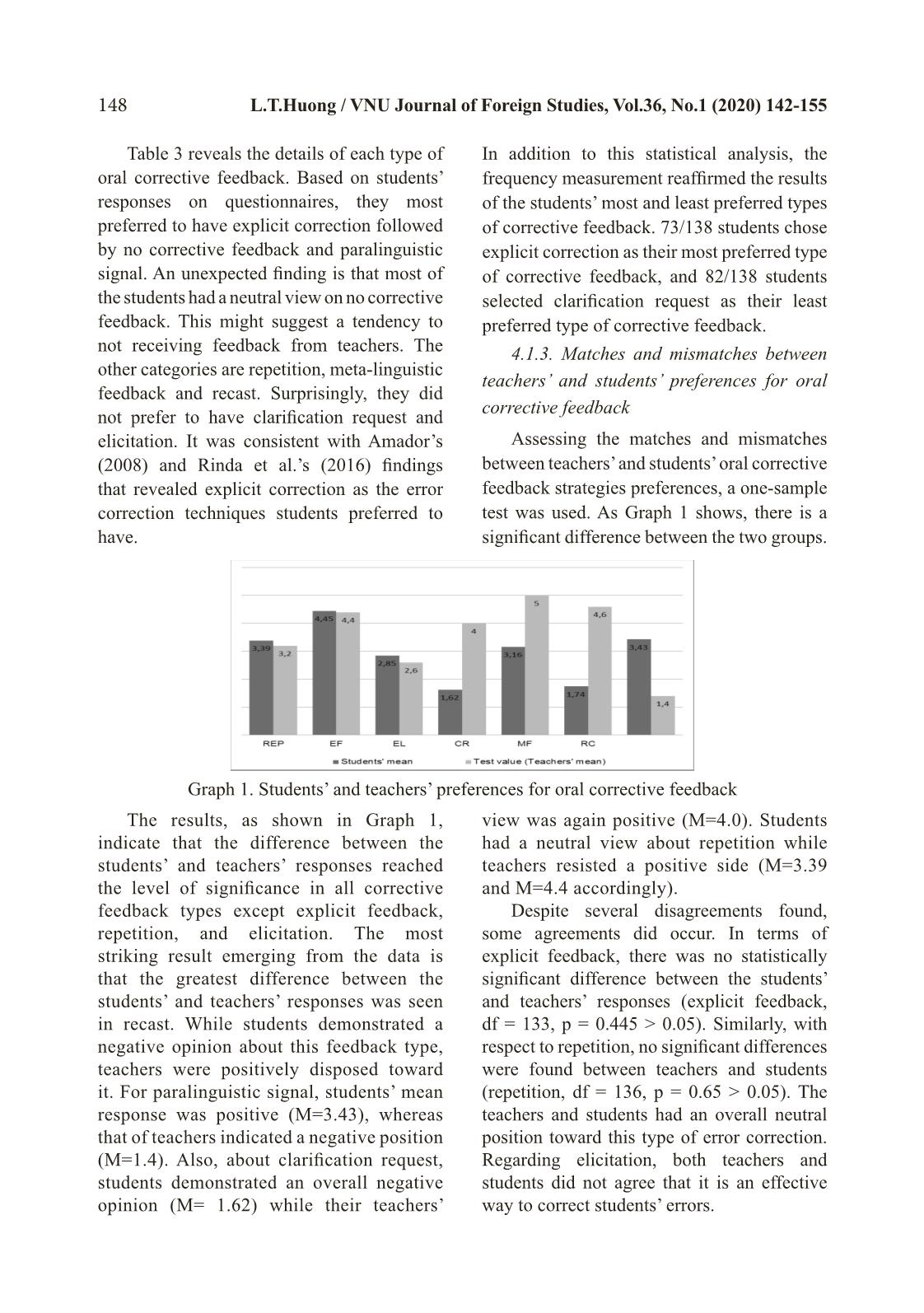
Trang 7
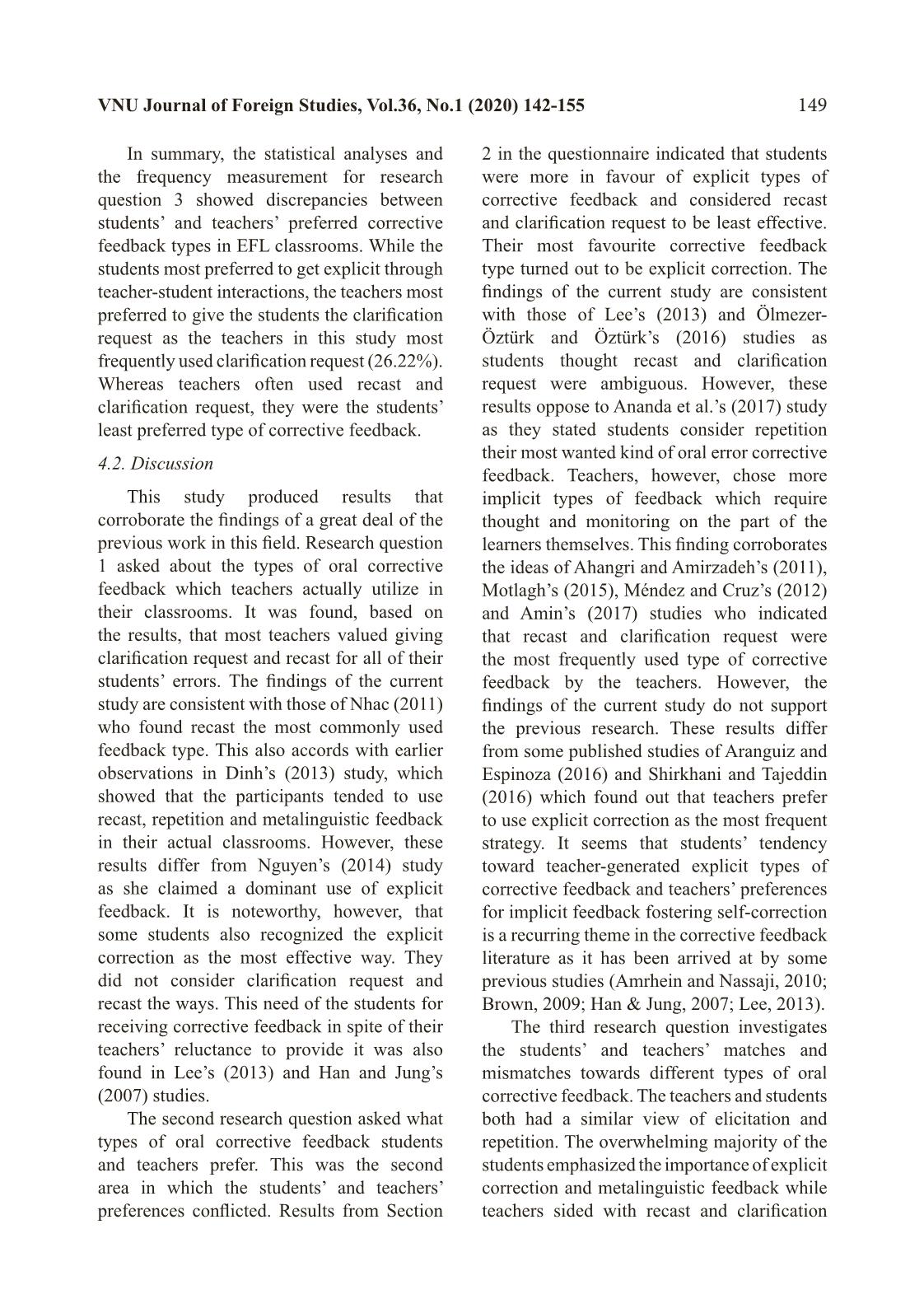
Trang 8
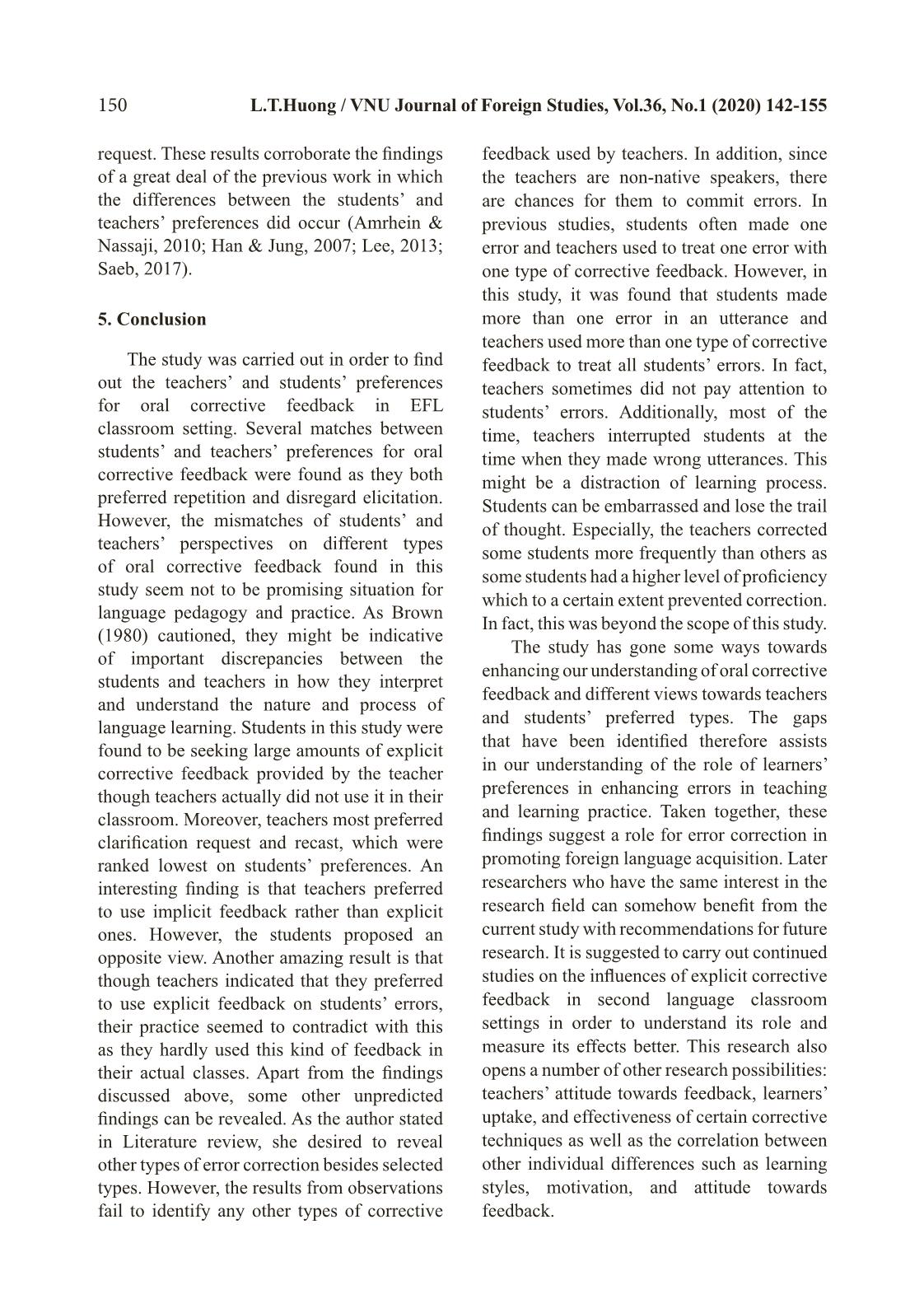
Trang 9
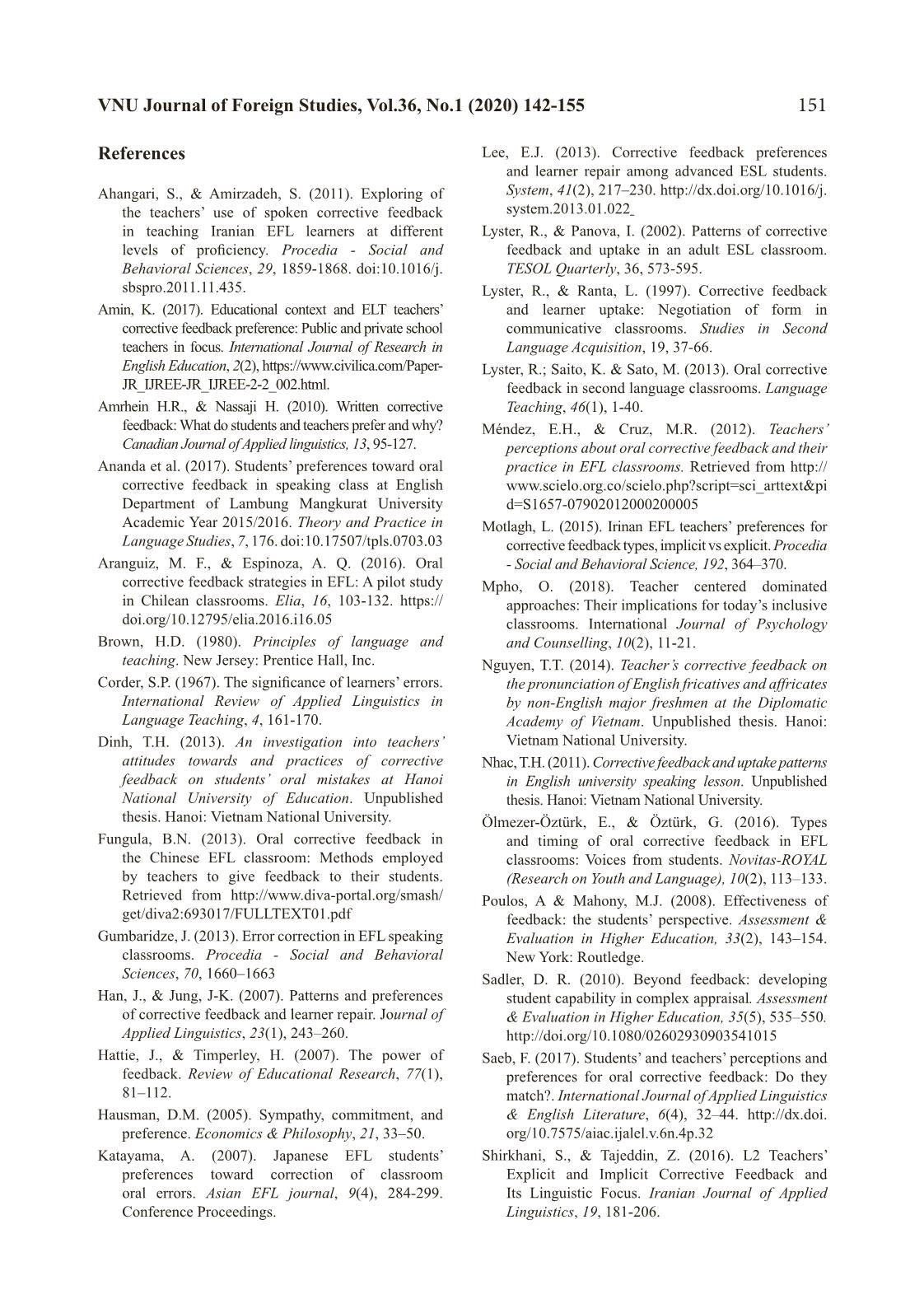
Trang 10
Tải về để xem bản đầy đủ
Bạn đang xem 10 trang mẫu của tài liệu "Matches and mismatches between EFL teachers’ and students’ preferences for corrective feedback in English speaking classes at a Vietnamese University", để tải tài liệu gốc về máy hãy click vào nút Download ở trên
Tóm tắt nội dung tài liệu: Matches and mismatches between EFL teachers’ and students’ preferences for corrective feedback in English speaking classes at a Vietnamese University
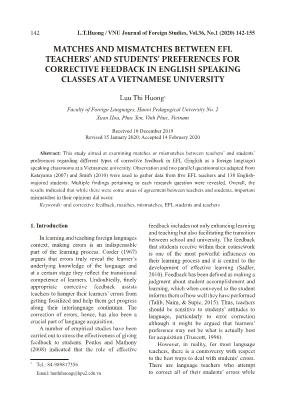
r stated in Literature review, she desired to reveal other types of error correction besides selected types. However, the results from observations fail to identify any other types of corrective feedback used by teachers. In addition, since the teachers are non-native speakers, there are chances for them to commit errors. In previous studies, students often made one error and teachers used to treat one error with one type of corrective feedback. However, in this study, it was found that students made more than one error in an utterance and teachers used more than one type of corrective feedback to treat all students’ errors. In fact, teachers sometimes did not pay attention to students’ errors. Additionally, most of the time, teachers interrupted students at the time when they made wrong utterances. This might be a distraction of learning process. Students can be embarrassed and lose the trail of thought. Especially, the teachers corrected some students more frequently than others as some students had a higher level of proficiency which to a certain extent prevented correction. In fact, this was beyond the scope of this study. The study has gone some ways towards enhancing our understanding of oral corrective feedback and different views towards teachers and students’ preferred types. The gaps that have been identified therefore assists in our understanding of the role of learners’ preferences in enhancing errors in teaching and learning practice. Taken together, these findings suggest a role for error correction in promoting foreign language acquisition. Later researchers who have the same interest in the research field can somehow benefit from the current study with recommendations for future research. It is suggested to carry out continued studies on the influences of explicit corrective feedback in second language classroom settings in order to understand its role and measure its effects better. This research also opens a number of other research possibilities: teachers’ attitude towards feedback, learners’ uptake, and effectiveness of certain corrective techniques as well as the correlation between other individual differences such as learning styles, motivation, and attitude towards feedback. 151VNU Journal of Foreign Studies, Vol.36, No.1 (2020) 142-155 References Ahangari, S., & Amirzadeh, S. (2011). Exploring of the teachers’ use of spoken corrective feedback in teaching Iranian EFL learners at different levels of proficiency. Procedia - Social and Behavioral Sciences, 29, 1859-1868. doi:10.1016/j. sbspro.2011.11.435. Amin, K. (2017). Educational context and ELT teachers’ corrective feedback preference: Public and private school teachers in focus. International Journal of Research in English Education, 2(2), https://www.civilica.com/Paper- JR_IJREE-JR_IJREE-2-2_002.html. Amrhein H.R., & Nassaji H. (2010). Written corrective feedback: What do students and teachers prefer and why? Canadian Journal of Applied linguistics, 13, 95-127. Ananda et al. (2017). Students’ preferences toward oral corrective feedback in speaking class at English Department of Lambung Mangkurat University Academic Year 2015/2016. Theory and Practice in Language Studies, 7, 176. doi:10.17507/tpls.0703.03 Aranguiz, M. F., & Espinoza, A. Q. (2016). Oral corrective feedback strategies in EFL: A pilot study in Chilean classrooms. Elia, 16, 103-132. https:// doi.org/10.12795/elia.2016.i16.05 Brown, H.D. (1980). Principles of language and teaching. New Jersey: Prentice Hall, Inc. Corder, S.P. (1967). The significance of learners’ errors. International Review of Applied Linguistics in Language Teaching, 4, 161-170. Dinh, T.H. (2013). An investigation into teachers’ attitudes towards and practices of corrective feedback on students’ oral mistakes at Hanoi National University of Education. Unpublished thesis. Hanoi: Vietnam National University. Fungula, B.N. (2013). Oral corrective feedback in the Chinese EFL classroom: Methods employed by teachers to give feedback to their students. Retrieved from get/diva2:693017/FULLTEXT01.pdf Gumbaridze, J. (2013). Error correction in EFL speaking classrooms. Procedia - Social and Behavioral Sciences, 70, 1660–1663 Han, J., & Jung, J-K. (2007). Patterns and preferences of corrective feedback and learner repair. Journal of Applied Linguistics, 23(1), 243–260. Hattie, J., & Timperley, H. (2007). The power of feedback. Review of Educational Research, 77(1), 81–112. Hausman, D.M. (2005). Sympathy, commitment, and preference. Economics & Philosophy, 21, 33–50. Katayama, A. (2007). Japanese EFL students’ preferences toward correction of classroom oral errors. Asian EFL journal, 9(4), 284-299. Conference Proceedings. Lee, E.J. (2013). Corrective feedback preferences and learner repair among advanced ESL students. System, 41(2), 217–230. system.2013.01.022 Lyster, R., & Panova, I. (2002). Patterns of corrective feedback and uptake in an adult ESL classroom. TESOL Quarterly, 36, 573-595. Lyster, R., & Ranta, L. (1997). Corrective feedback and learner uptake: Negotiation of form in communicative classrooms. Studies in Second Language Acquisition, 19, 37-66. Lyster, R.; Saito, K. & Sato, M. (2013). Oral corrective feedback in second language classrooms. Language Teaching, 46(1), 1-40. Méndez, E.H., & Cruz, M.R. (2012). Teachers’ perceptions about oral corrective feedback and their practice in EFL classrooms. Retrieved from http:// www.scielo.org.co/scielo.php?script=sci_arttext&pi d=S1657-07902012000200005 Motlagh, L. (2015). Irinan EFL teachers’ preferences for corrective feedback types, implicit vs explicit. Procedia - Social and Behavioral Science, 192, 364–370. Mpho, O. (2018). Teacher centered dominated approaches: Their implications for today’s inclusive classrooms. International Journal of Psychology and Counselling, 10(2), 11-21. Nguyen, T.T. (2014). Teacher’s corrective feedback on the pronunciation of English fricatives and affricates by non-English major freshmen at the Diplomatic Academy of Vietnam. Unpublished thesis. Hanoi: Vietnam National University. Nhac, T.H. (2011). Corrective feedback and uptake patterns in English university speaking lesson. Unpublished thesis. Hanoi: Vietnam National University. Ölmezer-Öztürk, E., & Öztürk, G. (2016). Types and timing of oral corrective feedback in EFL classrooms: Voices from students. Novitas-ROYAL (Research on Youth and Language), 10(2), 113–133. Poulos, A & Mahony, M.J. (2008). Effectiveness of feedback: the students’ perspective. Assessment & Evaluation in Higher Education, 33(2), 143–154. New York: Routledge. Sadler, D. R. (2010). Beyond feedback: developing student capability in complex appraisal. Assessment & Evaluation in Higher Education, 35(5), 535–550. Saeb, F. (2017). Students’ and teachers’ perceptions and preferences for oral corrective feedback: Do they match?. International Journal of Applied Linguistics & English Literature, 6(4), 32–44. org/10.7575/aiac.ijalel.v.6n.4p.32 Shirkhani, S., & Tajeddin, Z. (2016). L2 Teachers’ Explicit and Implicit Corrective Feedback and Its Linguistic Focus. Iranian Journal of Applied Linguistics, 19, 181-206. 152 L.T.Huong / VNU Journal of Foreign Studies, Vol.36, No.1 (2020) 142-155 Talib, R., Naim, H., & Supie, H. (2015). UTM postgraduate students’ perspective on feedback practices in higher education. International Education Studies, 8(13), 17-21. Truscott, J. (1996). The case against grammar correction in L2 writing class. Language Learning, 46, 327–369. Yoshida, R. (2008). Teachers’ choice and learners’ preference of corrective feedback types. Language Awareness, 17(1), 78–93. org/10.2167/la429. TƯƠNG ĐỒNG VÀ KHÁC BIỆT VỀ QUAN ĐIỂM CỦA GIÁO VIÊN VÀ SINH VIÊN TIẾNG ANH ĐỐI VỚI PHẢN HỒI SỬA LỖI TRONG KỸ NĂNG NÓI Ở MỘT TRƯỜNG ĐẠI HỌC VIỆT NAM Lưu Thị Hương Khoa Ngoại ngữ, Trường Đại học Sư phạm Hà Nội 2 Xuân Hòa, Phúc Yên, Vĩnh Phúc, Việt Nam Tóm tắt: Nghiên cứu này tìm hiểu những sự tương đồng và khác biệt giữa những sở thích đối với phản hồi sửa lỗi của giáo viên và sinh viên tiếng Anh như là một ngoại ngữ trong lớp học nói tiếng Anh ở một trường đại học Việt Nam. Công cụ sử dụng để thu thập dữ liệu cho nghiên cứu là quan sát lớp học và bảng câu hỏi khảo sát cho giáo viên và sinh viên. Đối tượng nghiên cứu là 05 giáo viên và 138 sinh viên ngành tiếng Anh. Nghiên cứu chỉ ra nhiều kết quả cho từng câu hỏi nghiên cứu. Kết quả cho thấy dù có sự tương đồng giữa những sở thích của sinh viên và giáo viên, một số sự khác biệt cũng được phát hiện trong nghiên cứu này. Từ khoá: phản lỗi chữa lỗi bằng lời nói, sự tương đồng, sự khác biệt, giáo viên và sinh viên ngành tiếng Anh APPENDICES APPENDIX A: CLASSROOM OBSERVATION SHEET ON TEACHERS’ ORAL CORRECTIVE FEEDBACK General information Observer: Instructor: Date of observation: Year level: Class: Number of boys: Number of girls: Start time: Finish time: Lesson topic: CLASSROOM OBSERVATION TALLY SHEET Feedback strategies Tallies Total 1 Teacher says nothing. 153VNU Journal of Foreign Studies, Vol.36, No.1 (2020) 142-155 2 Repetition: The teacher emphasizes the student’s grammatical error by changing his/her tone of voice. 3 Explicit feedback: The teacher gives the correct form to the student with a grammatical explanation. 4 Elicitation: The teacher asks the student to correct and complete the sentence. 5 Clarification request: The teacher does not give corrective feedback on the student’s errors. 6 Metalinguistic feedback: The teacher gives a hint or a clue without specifically pointing out the mistake. 7 Recast: The teacher repeats the student’s utterance in the correct form without pointing out the student’s error. 8 Paralinguistic signal: Teacher rises eyebrows to tell that the student has made error and is expected to self-correct. Details Coding scheme: T: Teacher S: Student No. Example of students’ errors Teacher’s response Types of oral corrective feedback 1 2 3 APPENDIX B: QUESTIONNAIRE ON TEACHERS’ AND STUDENTS’ PREFERENCES TOWARDS TYPES OF ORAL CORRECTIVE FEEDBACK IN SPEAKING CLASSROOMS B.1. STUDENTS’ QUESTIONNAIRE The purpose of this study is to investigate the preferences of teachers and students at Faculty of Foreign Languages at Hanoi Pedagogical University 2 about error correction. The information gathered will be used for research on corrective feedback in language classrooms with a view to finding out the matches and mismatches to adjust it during learning and teaching process. There are no risks or benefits to you from participating in this research. Thank you very much. A: DEMOGRAPHY 1. Gender: Tick ✓your gender. Male Female 2. Age: ... 3. Email: . 4. Hometown: . 5. How long have you been learning English? Put a tick ✓. Less than 10 years 154 L.T.Huong / VNU Journal of Foreign Studies, Vol.36, No.1 (2020) 142-155 More than 10 years 6. Major: Tick ✓your major. English Linguistics English Language Teaching 7. Year: Tick ✓your course. K41 K42 K43 K44 Please tick ✓the information that applies to you. Make sure to mark only one. B: How do you rate each type of spoken error correction below? 1 = Very ineffective 4 = Effective 2 = Ineffective 5 = Very Effective 3 = Neutral Teacher: What is he talking about? Student: He talks about his garden. No. 1 2 3 4 5 8 Teacher says nothing. 9 He talks? (Repetition: The teacher emphasizes the student’s grammatical error by changing his/her tone of voice.) 10 Talks is the simple present tense. In this case you need to use the continuous present tense. (Explicit feedback: The teacher gives the correct form to the student with a grammatical explanation.) 11 At the moment, he (Elicitation: The teacher asks the student to correct and complete the sentence.) 12 Excuse me? (Clarification request: The teacher does not give corrective feedback on the student’s errors.) 13 When we are speaking about something that happens right now which tense do we use? (Metalinguistic feedback: The teacher gives a hint or a clue without specifically pointing out the mistake.) 14 He is talking about his garden. (Recast: The teacher repeats the student’s utterance in the correct form without pointing out the student’s error.) 15 Teacher rises eyebrows to tell that the student has made error and is expected to self-correct. (Paralinguistic signal) B.2. TEACHERS’ QUESTIONNAIRE The purpose of this study is to investigate the preferences of teachers and students at Faculty of Foreign Languages at Hanoi Pedagogical University 2 about error correction. The information gathered will be used for research on corrective feedback in language classrooms with a view to finding out the matches and mismatches to adjust it during learning and teaching process. There are no risks or benefits to you from participating in this research. Thank you very much. 155VNU Journal of Foreign Studies, Vol.36, No.1 (2020) 142-155 A: DEMOGRAPHY 1. Gender: Tick ✓your gender. Male Female 2. Age: 3. Email: . 4. Hometown: . 5. How long have you been teaching English? Put a tick ✓. less than 5 years 5-10 years more than 10 years 6. Tick ✓to the box that indicates the course you are teaching. K41 K42 K43 K44 Please tick ✓the information that applies to you. Make sure to mark only one. B: How do you rate each type of spoken error correction below? 1 = Very Ineffective 4 = Effective 2 = Ineffective 5 = Very Effective 3 = Neutral Teacher: What is he talking about? Student: He talks about his garden. STT 1 2 3 4 5 7 Teacher says nothing. 8 He talks? (Repetition: The teacher emphasizes the student’s grammatical error by changing his/her tone of voice.) 9 Talks is the simple present tense. In this case you need to use the continuous present tense. (Explicit feedback: The teacher gives the correct form to the student with a grammatical explanation.) 10 At the moment, he (Elicitation: The teacher asks the student to correct and complete the sentence.) 11 Excuse me? (Clarification request: The teacher does not give corrective feedback on the student’s errors.) 12 When we are speaking about something that happens right now which tense do we use? (Metalinguistic feedback: The teacher gives a hint or a clue without specifically pointing out the mistake.) 13 He is talking about his garden. (Recast: The teacher repeats the student’s utterance in the correct form without pointing out the student’s error.) 14 Teacher rises eyebrows to tell that the student has made error and is expected to self-correct. (Paralinguistic signal)
File đính kèm:
 matches_and_mismatches_between_efl_teachers_and_students_pre.pdf
matches_and_mismatches_between_efl_teachers_and_students_pre.pdf

